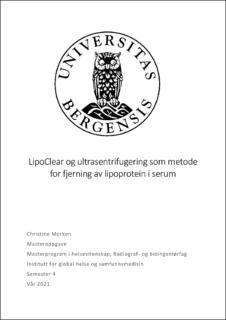| dc.contributor.author | Morken, Christine | |
| dc.date.accessioned | 2021-06-18T08:48:43Z | |
| dc.date.issued | 2021-05-15 | |
| dc.date.submitted | 2021-06-17T22:00:31Z | |
| dc.identifier.uri | https://hdl.handle.net/11250/2760081 | |
| dc.description.abstract | Bakgrunn: Hensikten med studien var å sammenligne LipoClear og ultrasentrifugering som metoder for å fjerne lipoproteiner i serum i pasientprøver med sterk lipemisk interferens for 10 biokjemiske analytter. Materiale og metode: Det ble utført 3 delforsøk med de 2 respektive metodene i følgende prøvematerialer: Del 1. Femten ikke-lipemiske pasientprøver, Del 2. En serumpool ble tilsatt Intralipid til L-indeks tilsvarende 100, 300, 500 og 750, med 3 prøver for hver indeks, og Del 3. Tjue naturlig lipemiske pasientprøver. Delforsøkene sammenlignet metodenes kvalitet i forhold til gjenfinnbarhet, L-indeks, og naturlig lipemiske prøver. Avvik ble vurdert med t-test, Passing-Bablok regresjon eller bias. Resultat: Del 1: LipoClear viser signifikant avvik ved t-test for natrium, kalium, glukose, kreatinin, albumin og fosfat, mens ultrasentrifugering viste signifikante avvik for natrium, kalium, klorid og fosfat. LipoClear overstiger krav til bias basert på biologisk variasjon for natrium, klorid, glukose, albumin og fosfat, ultrasentrifugering for klorid. Passing-Bablok viser bias for glukose, kalsium, kreatinin og albumin ved LipoClear-behandling og for kalsium ved ultrasentrifugering. Del 2: LipoClear overstiger krav til bias basert på biologisk variasjon ved tre eller flere L-indekser for natrium, klorid, glukose, kalsium, kreatinin, albumin og fosfat ved LipoClear-behandling. Ultrasentrifugering overstiger krav til bias for to eller flere L-indekser testet for klorid, albumin og kalsium. Del 3: Begge metoder viste større prosentvis variasjon i naturlig lipemiske pasientprøver enn i serumpool tilsatt Intralipid. Konklusjon: Behandling med LipoClear bør ikke benyttes til å fjerne lipemisk interferens i serum ved analysering av natrium, glukose, kreatinin, albumin og fosfat. Ultrasentrifugering av lipemisk serum bør ikke benyttes ved analysering av albumin. Ny prosedyre for behandling av sterkt lipemisk interferens bør være basert på bruk av ultrasentrifugering. | |
| dc.description.abstract | Background: The aim of the study was to compare LipoClear and ultracentrifugation as methods for removing lipemia in patient samples. Materials and methods: Three sub-experiments with the respective methods were conducted in following materials: Part 1: Fifteen non-lipemic patient samples, Part 2: A serum pool spiked with Intralipid to L-index of 100, 300, 500 and 750, with 3 samples in each, Part 3: Twenty natural lipemic patient. The sub-experience compared the quality of the methods with regard to recovery, L-index and natural lipemic samples. Deviation was assessed with t-test, Passing-Bablok regression or bias. Results: Part 1: Pared sample t-test showed significant difference in sodium, potassium, glucose, creatinine, albumin and phosphate after treatment with LipoClear, and in sodium, potassium, chloride and phosphate with ultracentrifugation. Passing-Bablok regression shows bias on glucose, calcium, creatinine, albumin after treatment with LipoClear, and on calcium after ultracentrifugation. LipoClear exceeds the bias requirements based on biological variation for sodium, chloride, glucose, albumin and phosphate. Ultracentrifugation exceeded the same bias requirements for chloride. Part 2: LipoClear exceeds the bias requirements based on biological variation for three or more L-indexes tested for sodium, chloride, glucose, calcium, creatinine, albumin and phosphate. Ultracentrifugation exceeded the same bias requirements for two or more L-indexes tested for chloride, albumin and calcium. Part 3: Both methods showed greater percentage difference in natural lipemic patient samples compared with serum pool spiked with Intralipid. Conclusion: LipoClear is not suitable for lipemia removal from samples designated for sodium, glucose, creatinine, albumin and phosphate measurements. Ultracentrifugation is not suitable for lipemia removal from samples designated for albumin measurements. A procedure for treatment of lipemic patient samples should be based on the use of ultracentrifugation. | |
| dc.language.iso | nob | |
| dc.publisher | The University of Bergen | |
| dc.rights | Copyright the Author. All rights reserved | |
| dc.subject | ultracentrifuge | |
| dc.subject | ultrasentrifuge | |
| dc.subject | kvalitetsforbedring Interference | |
| dc.subject | Interferens | |
| dc.subject | lipemi | |
| dc.subject | LipoClear | |
| dc.subject | quality improvement | |
| dc.subject | lipemia | |
| dc.title | LipoClear og ultrasentrifugering som metode for fjerning av lipoprotein i serum | |
| dc.title.alternative | LipoClear and ultracentrifugation as methods for removing lipemia in serum | |
| dc.type | Master thesis | |
| dc.date.updated | 2021-06-17T22:00:31Z | |
| dc.rights.holder | Copyright the Author. All rights reserved | |
| dc.description.degree | Masteroppgåve for radiograf/bioingeniør | |
| dc.description.localcode | RABD395 | |
| dc.description.localcode | MAMD-HELSE | |
| dc.subject.nus | 761901 | |
| fs.subjectcode | RABD395 | |
| fs.unitcode | 13-26-0 | |
| dc.date.embargoenddate | 2022-05-15 | |
